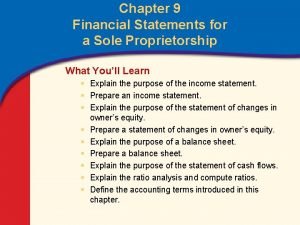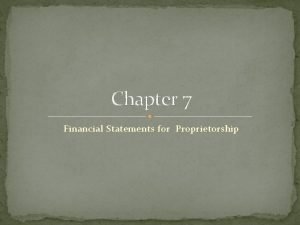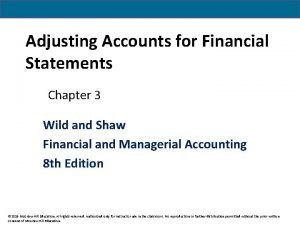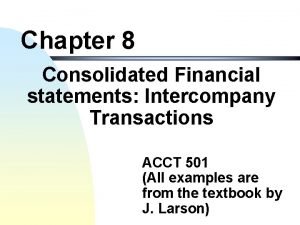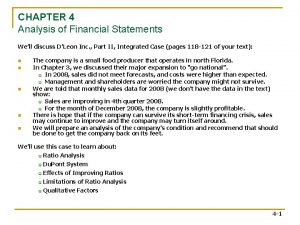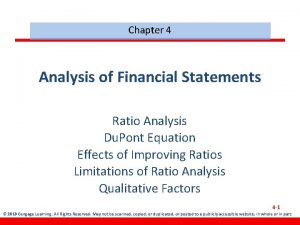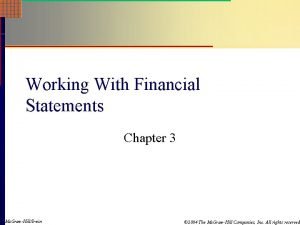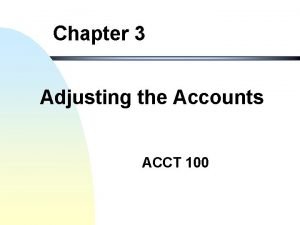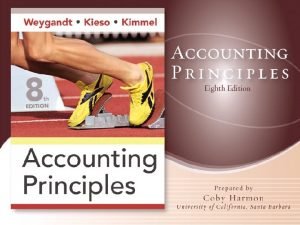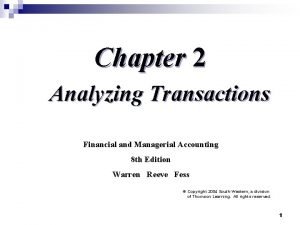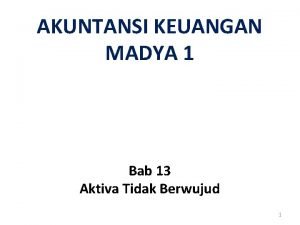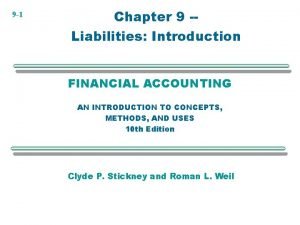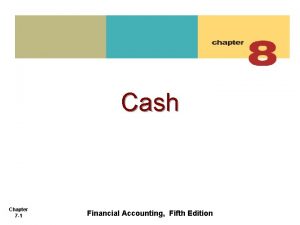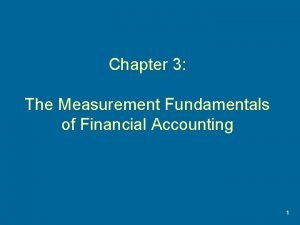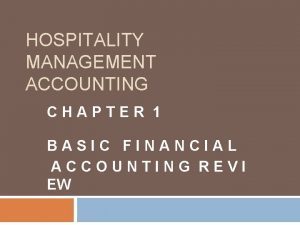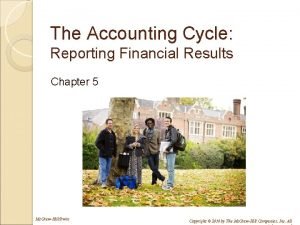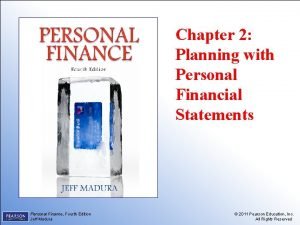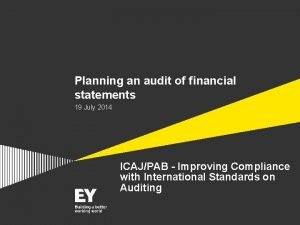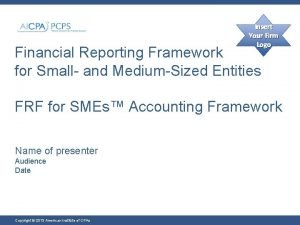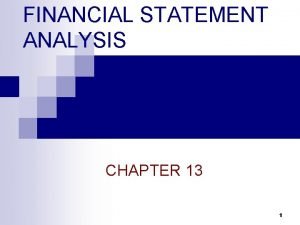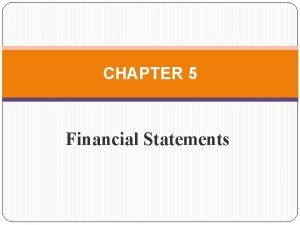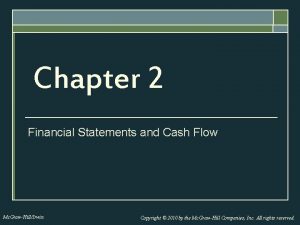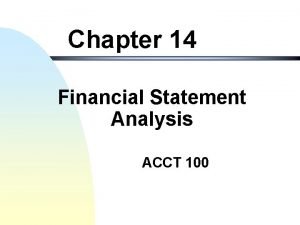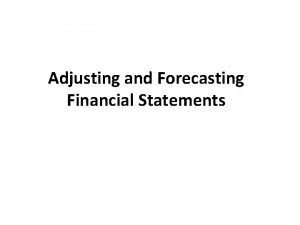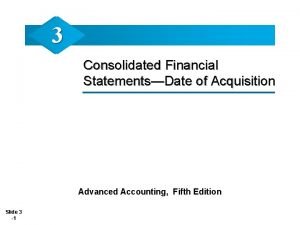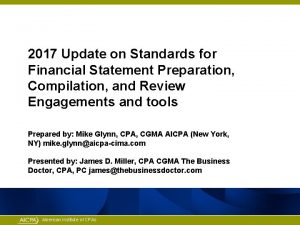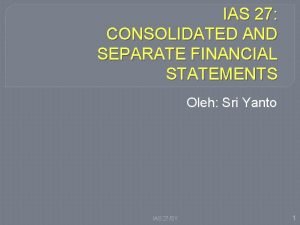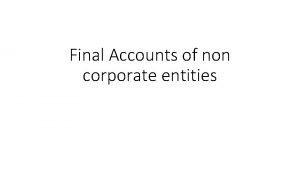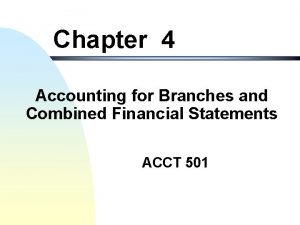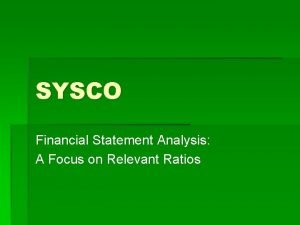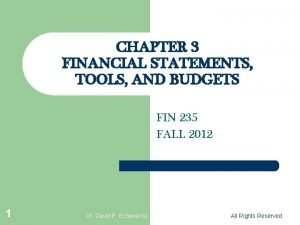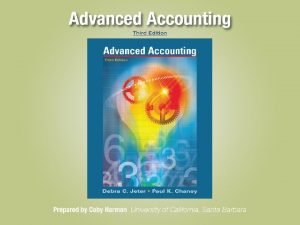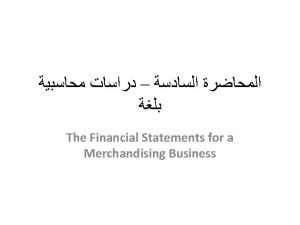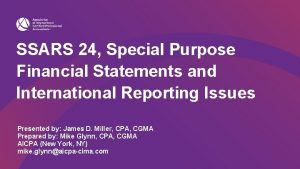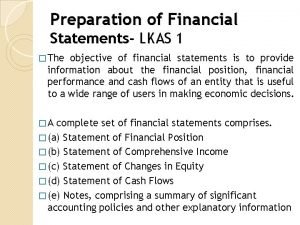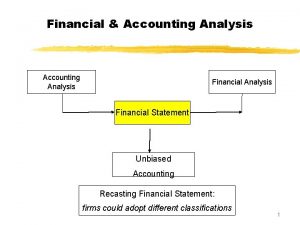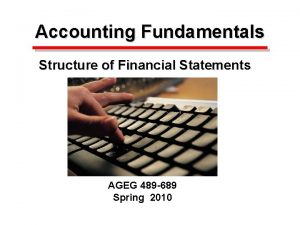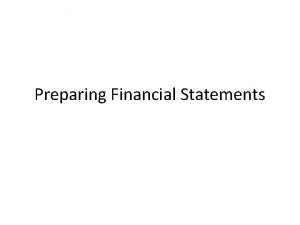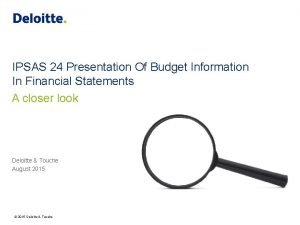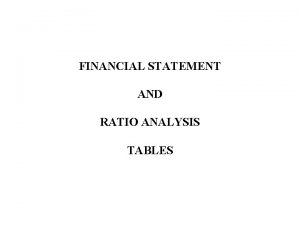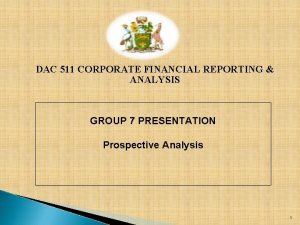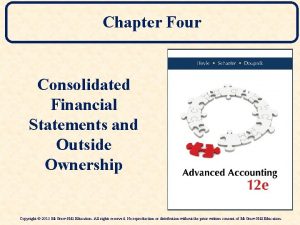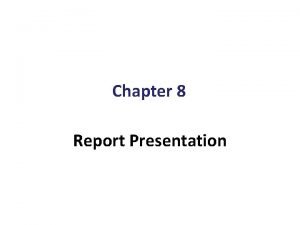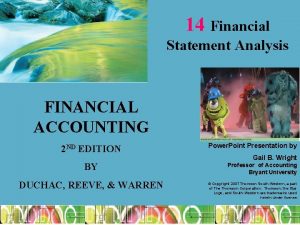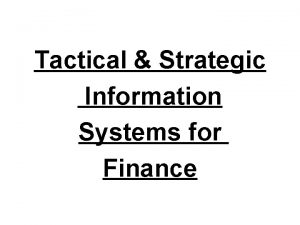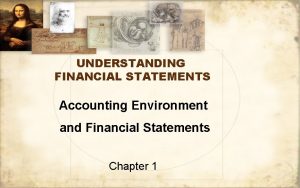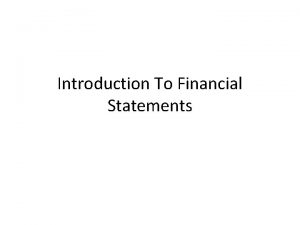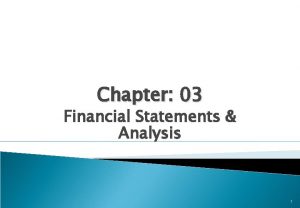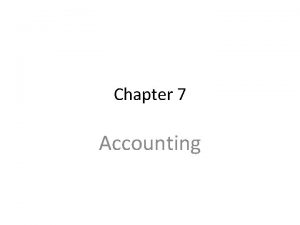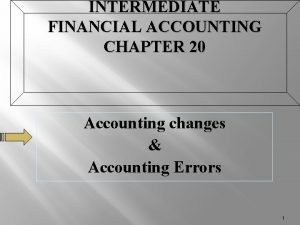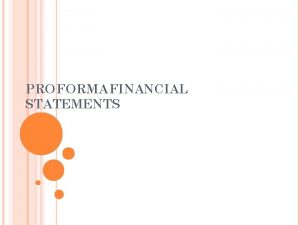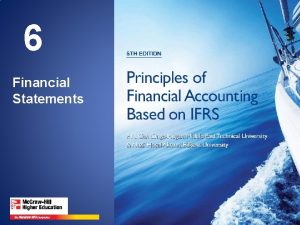Financial Statements Personal Accounting Checklist Chapter 1 Meaning












































































- Slides: 76

Financial Statements: Personal Accounting

Checklist Chapter 1 Meaning of Accounting and Introduction to Net Worth The Balance Sheet The Income Statement The Accounting Equation Accrual Accounting Incurring Debt and Buying & Selling Assets Depreciation Prepaid Expenses Sources and Uses of Cash Market Value vs. Book Value

Meaning of Accounting The purpose of accounting: • To accurately measure all the financial activities of an individual or business. • It is important to maintain records of activities that increase or decrease your net worth.

Introduction to Net Worth is what would remain if you choose to cash out by selling all your assets and paying everything that you owe. It compares: How much you own (assets) vs. How much you owe (liabilities)

Introduction to Net Worth is what would remain if you choose to cash out by selling all your assets and paying everything that you owe. The most common way to increase your net worth: Revenue increase in net worth caused by providing goods or services (e. g. earning salary). The most common way to decrease your net worth: Expenses decrease in net worth from the costs of day-to-day activities (e. g. paying your utilities and gas bill).

Checklist Chapter 1 Meaning of Accounting and Introduction to Net Worth The Balance Sheet The Income Statement The Accounting Equation Accrual Accounting Incurring Debt and Buying & Selling Assets Depreciation Prepaid Expenses Sources and Uses of Cash Market Value vs. Book Value

The Balance Sheet Records what we own (assets) vs. what we owe (liabilities) OWE OWN Provides a snapshot of your financial position at a specific date

The Balance Sheet Sample Personal Balance Sheet The following is a sample balance sheet that lists the values of an individual’s assets, liabilities and resulting net worth at a particular date (December 31, 2011).

The Balance Sheet Personal Balance Sheet A large cash balance does not necessarily imply a high net worth. Similarly, a low cash balance does not necessary imply a low net worth. Shown below are two personal balance sheets that illustrate this concept. Here, there is a negative cash balance, meaning that the bank account is over-drawn. This is known as bank overdraft.

The Balance Sheet - Question What is the role of the balance sheet? a. b. c. d. Record expenses Record what we own versus what we owe Record what we earn versus what we owe Record all financial transactions

Checklist Chapter 1 Meaning of Accounting and Introduction to Net Worth The Balance Sheet The Income Statement The Accounting Equation Accrual Accounting Incurring Debt and Buying & Selling Assets Depreciation Prepaid Expenses Sources and Uses of Cash Market Value vs. Book Value

The Income Statement Revenues and Expenses The income statement allows you to keep a clean record of changes to net worth relating to revenues and expenses. The excess of revenues over expenses is called a surplus. If expenses exceeds revenues, then the difference is called a deficit. Revenues Expenses Surplus As will be shown later, a surplus increases net worth and deficit decreases net worth.

The Income Statement E. g. Salary earned (increases net worth) Costs of day-to-day activities (decreases net worth) Surplus (Deficit)

The Income Statement Accounting Periods Changes to net worth are tracked for separate periods called accounting periods. Because the income statement covers a summary of activities for a period of time, the date of income statement is presented in the following form: ‘For the Period Ended…’. For example, an income statement prepared on March 30, 2013 covering three months would have the date ‘For the Three Months Ended March 30, 2013’.

The Income Statement - Question What is the role of the income statement? a. b. c. d. Record only cash sales and expenses Record what we own versus what we owe Record revenues and expenses Record all financial transactions

The Income Statement - Question What does the income statement consist of? a. b. c. d. Permanent accounts Temporary accounts Transaction accounts Reserve accounts

Solution b. Temporary accounts Why? • Only required during a period to track the changes to net worth (revenue and expenses). • A new period commences with a fresh income statement.

Checklist Chapter 1 Meaning of Accounting and Introduction to Net Worth The Balance Sheet The Income Statement The Accounting Equation Accrual Accounting Incurring Debt and Buying & Selling Assets Depreciation Prepaid Expenses Sources and Uses of Cash Market Value vs. Book Value

The Accounting Equation Assets = Liabilities + Net Worth Double entry system: • Each transaction has at least two entries • The logic is similar to Newton’s Third Law (‘For every action, there is an equal and opposite reaction. ’) • In the absence of a logical opposite entry, the balance sheet will not balance The accounting equation re-arranged: Net Worth = Assets - Liabilities

Accounting Equation as a Scale The scale must always be in balance.

Accounting Equation as a Scale What initially happens to the scale when depositing $3, 000 of salary? The scale goes out of balance.

Accounting Equation as a Scale To get the scale back in balance you must increase net worth. An increase to net worth (recording the revenue side of the transaction) brings the scale back into balance.

The Accounting Equation Net Worth Calculation Ending Net Worth = Beginning Net Worth + Capital + Surplus (Deficit) Beginning Net Worth: • Balance of net worth at the beginning of the period being considered. Capital: • Increases to net worth other than revenue (e. g. gifts or lottery winnings). Surplus (Deficit): • The amount by which revenues exceed expenses (or expenses exceed revenues) for the period. The amount is taken from the personal income statement. A surplus increases net worth and a deficit decreases net worth.

Net Worth Calculation - Question In year 2013, your opening net worth was $14, 000 and total assets were $7, 000. Your personal income statement showed a deficit of $3, 000. What is your net worth as at December 31, 2013? a. b. c. d. $18, 000 $11, 000 $24, 000 $17, 000

The Accounting Equation Introduction to T-Accounts An account allows us to track detailed information about the values of individual items (e. g. cash, unpaid accounts, food expense, etc. ). A T-Account, a chart in the shape of a ‘T’, records transactions and tracks the balances of each account. A sample, empty T-Account:

The Accounting Equation Introduction to T-Accounts: The Process Recording information in a T-Account: 1. Enter the opening balances in the appropriate accounts (if applicable). Also, check that the accounting equation is in balance before you begin entering transactions. $80, 000

The Accounting Equation Introduction to T-Accounts: The Process 2. Enter both sides of the transaction under the correct account in the balance sheet and/or income statement. Be sure to record the transaction numbers so that you can check your work. For instance, assume the transaction is as follows: #1: Earned and deposited $3, 000 in salary ASSETS (what we own) INCREASE (DR) + DECREASE (CR) CASH Opening Balance $5, 000 - DECREASE (DR) - INCREASE (CR) REVENUE + 1. $3, 000 1. $3, 000 Total: $8, 000 Note: each transaction will have at least one entry on the left side of the T-Account and at least one entry on the right side of another T-Account.

The Accounting Equation Introduction to T-Accounts: The Process 3. Calculate the surplus or deficit in the income statement and transfer the amount to net worth in the balance sheet.

The Accounting Equation Introduction to T-Accounts: The Process 4. Calculate the surplus or deficit in the income statement and transfer the amount to net worth in the balance sheet. The following worksheet can be found on page 20 of the textbook.

T-Account Worksheet This form allows you to record the double entries for each transaction on opposite sides of each account.

Checklist Chapter 1 Meaning of Accounting and Introduction to Net Worth The Balance Sheet The Income Statement The Accounting Equation Accrual Accounting Incurring Debt and Buying & Selling Assets Depreciation Prepaid Expenses Sources and Uses of Cash Market Value vs. Book Value

Accrual Accounting and Matching Principle The principle of accrual accounting: • Revenue (an increase to net worth) and expenses (a decrease to net worth) should be recognized in the time period in which they occur, regardless of when the cash payment is received or made. There are two key principles to understand: - Cash flow relates to cash flowing into and out of the bank account, which is not necessarily directly connected to net worth. - Accruals relate to net worth, which does not necessarily connect to cash flow. The matching principle states: Expenses should be recorded in the same period as the revenues to which they are related

Accrual Accounting - Scenario #1 January: Use $100 worth of cell phone calls and pay in January. - 100 What happened to your net worth in January? Net worth decreased by $100 - 100 Expense

Accrual Accounting - Scenario #2 February: Use $100 worth of cell phone calls in January, but receive and pay the bill in February. In which month did your net worth decrease? (a) January when you used the phone, or + $100 (b) February when you paid the bill? Your net worth decreased in January when you increased your expense. - $100 Expense

Accrual Accounting - Question If you record a $500 credit card bill for gas expenses (due in one month), what is the effect on net worth? a. b. c. d. Stays the same Increases by $500 Decreases by $500 Not enough information is provided

The Matching Principle Assets less Liabilities January Salary EXPENSES $3, 000 $1, 000 = $3, 000 Expenses = $1, 000 1. In January you deposit $3, 000 salary – how much are you worth? 2. Charge $1, 000 of expenses to your credit card to be paid in February. Are you still worth $3, 000 in January? 3. Your Net Worth changed to $2, 000 because you recognized the expense of $1, 000 (decrease to net worth) $2, 000 $3, 000

The Matching Principle January Salary = $3, 000 Had you chosen to ignore these expenses in January, you would be under the 300 impression that you were richer in the amount of $3, 000, which is not true. You cannot ignore the fact that you incurred expenses in January, even if you didn’t pay for them in January and will pay for them in the future. Remember, under accrual accounting your net worth changes when expenses are incurred, not when cash is paid.

Accrual Accounting - Summary Recognize an expense (decrease to net worth) in the period in which you incurred the expense, regardless of whether or not you paid for it in that month. The matching principle states: Expenses should be recorded in the same period as the revenues to which they are related

Checklist Chapter 1 Meaning of Accounting and Introduction to Net Worth The Balance Sheet The Income Statement The Accounting Equation Accrual Accounting Incurring Debt and Buying & Selling Assets Depreciation Prepaid Expenses Sources and Uses of Cash Market Value vs. Book Value

Borrowing Money and Repaying Debt When you borrow money, you have more cash, but your net worth does not change. When you repay the principal portion of your debt, you have less cash, but your net worth still does not change

Borrowing Money and Repaying Debt Example: Borrowing cash from a friend 1 +$100 2 -$100 1. When borrowing $100 from a friend: - You are richer in cash, but there is no change to net worth - You still owe the cash. 2. When repaying your friend: - You are cash poorer, but there is still no change to net worth. NO CHANGE 1 +$100 2 -$100

Borrowing Money and Repaying Debt – Question What is the effect on net worth when borrowing money? a. b. c. d. Net worth increases Net worth decreases Net worth stays the same Net worth will change only when you repay the loan

Solution c. Net worth stays the same When borrowing cash you are: • cash flow richer • NOT net worth richer NO CHANGE

Borrowing Money and Repaying Debt – Question Paying the interest portion of a loan you borrowed: a. b. c. d. Reduces net worth Increases net worth Has nothing to do with net worth Could increase or decrease net worth

Solution a. Reduces net worth Interest expense will decrease net worth because cash will be used to pay the expense without an asset replacement or debt reduction. An expense means a reduction to net worth. [ DECREASES]

Buying and Selling Assets Buying or selling assets (according to the value stated in the balance sheet) also has no impact on net worth. Buying the car Selling the car NO CHANGE

Buying and Selling Assets Car Example Cost of the car $15, 000 Deposit paid from your savings $5, 000 Balance borrowed from ABC Finance $10, 000 In exchange for a $5, 000 Take a loan for cash deposit, the dealer $10, 000 in exchange only sends you the front of the car. for the balance of the car.

Buying and Selling Assets Car Example -$5, 000 +$5, 000 Pay $5, 000 cash for the front of the car. ? What is the transaction?

Buying and Selling Assets Car Example Take a loan for $10, 000 in exchange for the balance of the car. +$10, 000 ? What is the transaction?

Buying and Selling Assets Car Example What happened to your NET WORTH? No change! You just feel better with a new car!

Checklist Chapter 1 Meaning of Accounting and Introduction to Net Worth The Balance Sheet The Income Statement The Accounting Equation Accrual Accounting Incurring Debt and Buying & Selling Assets Depreciation Prepaid Expenses Sources and Uses of Cash Market Value vs. Book Value

Depreciation involves taking a portion of the asset’s cost and recording it as an expense for each period the asset is used. The asset’s value will be reduced on the balance sheet. Depreciation is used to deteriorate the value of an asset. Consider the following example: Suppose you purchased a computer for $1, 200. The computer is expected to last for three years before it is worn out or becomes worthless. As the computer is used, it needs to be depreciated to reflect the reduction in value. It will decrease by one third of its value each year: $1, 200 ÷ 3 years = $400 per year.

Depreciation Example

Depreciation - Question Suppose you bought furniture worth $6, 000. If the furniture is expect to last for 12 years, what is the annual depreciation? a. b. c. d. $1, 000 No depreciation $500 $250

Checklist Chapter 1 Meaning of Accounting and Introduction to Net Worth The Balance Sheet The Income Statement The Accounting Equation Accrual Accounting Incurring Debt and Buying & Selling Assets Depreciation Prepaid Expenses Sources and Uses of Cash Market Value vs. Book Value

Prepaid Expenses Prepaid expenses arise when expenses are paid for in advance. Insurance and rent are common examples. These prepayments are not considered expenses at the time they are paid because the services have not yet been provided. For example: You prepay for insurance today. The insurance company will provide you coverage for the next one-year period. You prepay rent at the end of April 2014 for three months’ worth of rent (which covers May, June and July 2014).

Prepaid Expenses – Other Examples Prepaid airline tickets Prepaid hotels Last month’s rent for your apartment Season’s baseball tickets Telephone calling cards

Prepaid Expenses Insurance Example Illustration of prepaid expenses: 1. You paid $1, 200 for insurance coverage for the coming year. 2. One month of insurance coverage has been used up

Prepaid Expenses - Question Accounting for prepaid expenses is an application of: a. b. c. d. cash flow accounting accrual accounting for debt none of the above

Prepaid Expenses Materiality Sometimes there are different ways to record a transaction. Each method could have an impact on: • Financial statements • Management decisions • Investors • Other stakeholders It is important that accountants do not mislead users of financial statements.

Prepaid Expenses Materiality Question: When we spend money on a purchase, how do we know whether to expense the amount (on the income statement) or treat it like an asset (add it to the balance sheet)? The concept of materiality: Record an asset as an expense if it does not make a significant difference to the balance sheet or income statement

Prepaid Expenses Materiality - Examples 1. You own $200, 000 of assets and purchase a $300 DVD player. Would you regard the DVD player as an asset? Discuss It depends. This is a judgment call. Is $300 a material amount? 2. Now you bought a $30 DVD. Would you regard the DVD as an asset or an expense? Discuss It can be argued to be either. One can argue that once the DVD is opened, it has no value, while someone else might say it is worth $10 for resale. It is often a question of judgment and materiality.

Checklist Chapter 1 Meaning of Accounting and Introduction to Net Worth The Balance Sheet The Income Statement The Accounting Equation Accrual Accounting Incurring Debt and Buying & Selling Assets Depreciation Prepaid Expenses Sources and Uses of Cash Market Value vs. Book Value

The Three Sources and Uses of Cash There are three ways of increasing or decreasing cash: 1. Activities that are day-to-day (earning and spending money on regular expenses). Ideally, you want to increase your cash position by ensuring your revenue exceeds you expenses. 2. By investing in or selling investments such as properties, stocks and mutual funds. 3. Through borrowing or paying back loans (called financing).

The Three Sources and Uses of Cash - Question Receiving a return on your stock investment is an example of which type of cash source? a. b. c. d. Day-to-day Investing Financing None of the above

Checklist Chapter 1 Meaning of Accounting and Introduction to Net Worth The Balance Sheet The Income Statement The Accounting Equation Accrual Accounting Incurring Debt and Buying & Selling Assets Depreciation Prepaid Expenses Sources and Uses of Cash Market Value vs. Book Value

Market Value vs. Book Value Market Value: The amount for which the asset could be sold on the open market. Your personal assets should be valued according to their market value (the same does not hold for businesses -> use book values primarily). Book Value: The difference between the purchase price of an asset and the amount of depreciation accumulated to date.

Market Value vs. Book Value In your personal finances, you can update your Net Worth with the Market Value of your asset. Example: You choose to depreciate your furniture over a five-year period. Market Value = $1, 200 Book Value = $1, 000 Personal finances: You should value the furniture at $1, 200 (Market Value). Business finances: To be conservative, a business would value the furniture at $1, 000 (Book Value).

Market Value vs. Book Value - Question The market value of a share is: a. b. c. d. The current share price The original purchase price Always greater than the original purchase price None of the above

Checklist Chapter 1 Meaning of Accounting and Introduction to Net Worth The Balance Sheet The Income Statement The Accounting Equation Accrual Accounting Incurring Debt and Buying & Selling Assets Depreciation Prepaid Expenses Sources and Uses of Cash Market Value vs. Book Value

Exercises Complete the following exercises.

Exercise #1 Mr. Dwight Elroy incurred the following transactions during the month of April 2011: Date April 1 April 2 April 3 April 15 April 28 Description Earned $2, 000 in cash salaries Paid $2, 400 in advance for insurance coverage up to March 31, 2012 Borrowed $3, 000 from a friend Paid $100 (with credit card) to dine at a fancy restaurant Repaid $500 worth of debt to friend Complete the following chart to account for the above transactions. Under the ‘Account Type’ column, fill the cells with one of the following: Asset, Liability, Revenue or Expense. The first transaction has been completed for you as an example.

Exercise #1 Complete the following chart to account for the above transactions. Under the ‘Account Type’ column, fill the cells with one of the following: Asset, Liability, Revenue or Expense. The first transaction has been completed for you as an example. Date April 1 Account Name Cash Revenue Account Type Asset Revenue Increase or Decrease Amount Increase $2, 000

Exercise #1 Answer: Date Account Name Account Type Increase or Decrease Amount April 1 April 2 Cash Revenue Asset Revenue Increase $2, 000 Prepaid Expenses Cash Asset Increase Decrease $2, 400 April 3 Cash Unpaid Accounts Asset Liability Increase $3, 000 April 15 Food Expense Unpaid Accounts Expense Liability Increase $100 April 28 Cash Unpaid Accounts Asset Liability Decrease $500

Exercise #2 Mark an X for each of the correct answers and whethere would be an increase, X decrease or no change – enter the new cash and net worth balances. x x x x x 4, 000 5, 000 4, 500 4, 300 3, 000 2, 500 7, 700 10, 700 x x x x x 3, 000 2, 500 2, 300 2, 300 5, 300

End of Chapter 1
 Financial accounting and accounting standards chapter 1
Financial accounting and accounting standards chapter 1 Unit 13 accounting and financial statements
Unit 13 accounting and financial statements Responsibility center ppt
Responsibility center ppt Chapter 03 financial analysis
Chapter 03 financial analysis The expense recognition principle aims to record
The expense recognition principle aims to record Financial statement of sole proprietorship
Financial statement of sole proprietorship Sole proprietorship financial statements
Sole proprietorship financial statements Adjusting accounts for financial statements
Adjusting accounts for financial statements Intercompany bond transactions
Intercompany bond transactions Chapter 4 analysis of financial statements
Chapter 4 analysis of financial statements Chapter 4 analysis of financial statements
Chapter 4 analysis of financial statements Financial statements and ratio analysis chapter 3
Financial statements and ratio analysis chapter 3 Cffa finance formula
Cffa finance formula Working with financial statements chapter 3
Working with financial statements chapter 3 Adjusting the accounts chapter 3
Adjusting the accounts chapter 3 Adjusting entry accrued expense
Adjusting entry accrued expense Managerial accounting chapter 2 solutions
Managerial accounting chapter 2 solutions Financial accounting chapter 13
Financial accounting chapter 13 Equity accounted investments
Equity accounted investments Financial accounting chapter 9
Financial accounting chapter 9 Financial accounting chapter 7
Financial accounting chapter 7 Financial accounting ifrs 4th edition chapter 12
Financial accounting ifrs 4th edition chapter 12 Financial accounting chapter 3
Financial accounting chapter 3 Chapter 2 financial accounting answers
Chapter 2 financial accounting answers Hospitality accounting basics
Hospitality accounting basics Financial accounting chapter 5
Financial accounting chapter 5 Chapter 13 personal financial management course
Chapter 13 personal financial management course Chapter 2 personal financial planning answers
Chapter 2 personal financial planning answers Grooming and hygiene checklist
Grooming and hygiene checklist Pshe calendar
Pshe calendar Purposes of financial statements
Purposes of financial statements Benefits of audit planning isa 300
Benefits of audit planning isa 300 Sample notes to financial statements for small entities
Sample notes to financial statements for small entities Analysis of financial statements
Analysis of financial statements Translate financial statements
Translate financial statements Fge financial management
Fge financial management 2-2 journal: financial statements and cash flow management
2-2 journal: financial statements and cash flow management Where is preferred dividends on financial statements
Where is preferred dividends on financial statements Forecasted financial statements
Forecasted financial statements Consolidated financial statements date of acquisition
Consolidated financial statements date of acquisition Ssars 21 preparation of financial statements
Ssars 21 preparation of financial statements Generally accepted accounting principles constrain
Generally accepted accounting principles constrain Ias 27
Ias 27 Standardized income statement
Standardized income statement Financial statements of non corporate entities
Financial statements of non corporate entities Home office and branch accounting
Home office and branch accounting Merchandising activities
Merchandising activities Four financial statements
Four financial statements Pwc ifrs 17 illustrative financial statements
Pwc ifrs 17 illustrative financial statements Sysco financial statements
Sysco financial statements Four primary financial statements
Four primary financial statements Financial statements tools
Financial statements tools Translation of financial statements
Translation of financial statements Income statement for sole trader
Income statement for sole trader Financial statements of a merchandising business
Financial statements of a merchandising business Special purpose financial statements
Special purpose financial statements Lkas 1
Lkas 1 Prospective accounting
Prospective accounting Translation of financial statements
Translation of financial statements Structure of financial statement
Structure of financial statement Common sized financial statements
Common sized financial statements Petty cash in income statement
Petty cash in income statement Financial statements
Financial statements Ipsas 24
Ipsas 24 Boeing balance sheet analysis
Boeing balance sheet analysis Hud audited financial statements chicago
Hud audited financial statements chicago Prospective analysis financial statements
Prospective analysis financial statements Financial analysis of banks
Financial analysis of banks Partial equity method consolidation worksheet
Partial equity method consolidation worksheet Aasb 8
Aasb 8 Bank of cyprus financial statements
Bank of cyprus financial statements Pixar financial statements
Pixar financial statements Oscar personal statements
Oscar personal statements Background of yourself example
Background of yourself example Non-financial methods of motivation
Non-financial methods of motivation What is tactical information system
What is tactical information system Statement of financial position
Statement of financial position





